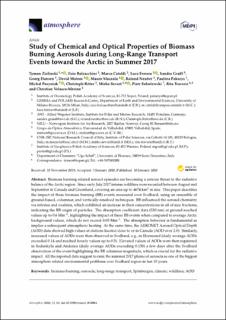| dc.contributor.author | Zielinski, Tymon | |
| dc.contributor.author | Bolzacchini, Ezio | |
| dc.contributor.author | Cataldi, Marco | |
| dc.contributor.author | Ferrero, Luca | |
| dc.contributor.author | Grassl, Sandra | |
| dc.contributor.author | Hansen, Georg Heinrich | |
| dc.contributor.author | Mateos, David | |
| dc.contributor.author | Mazzola, Mauro | |
| dc.contributor.author | Neuber, Roland | |
| dc.date.accessioned | 2020-03-13T12:39:00Z | |
| dc.date.available | 2020-03-13T12:39:00Z | |
| dc.date.created | 2020-03-04T12:41:00Z | |
| dc.date.issued | 2020 | |
| dc.identifier.citation | Atmosphere. 2020, 11, 84. | en_US |
| dc.identifier.issn | 2073-4433 | |
| dc.identifier.uri | https://hdl.handle.net/11250/2646749 | |
| dc.description.abstract | Biomass burning related aerosol episodes are becoming a serious threat to the radiative balance of the Arctic region. Since early July 2017 intense wildfires were recorded between August and September in Canada and Greenland, covering an area up to 4674 km2 in size. This paper describes the impact of these biomass burning (BB) events measured over Svalbard, using an ensemble of ground-based, columnar, and vertically-resolved techniques. BB influenced the aerosol chemistry via nitrates and oxalates, which exhibited an increase in their concentrations in all of size fractions, indicating the BB origin of particles. The absorption coefficient data (530 nm) at ground reached values up to 0.6 Mm–1, highlighting the impact of these BB events when compared to average Arctic background values, which do not exceed 0.05 Mm–1. The absorption behavior is fundamental as implies a subsequent atmospheric heating. At the same time, the AERONET Aerosol Optical Depth (AOD) data showed high values at stations located close to or in Canada (AOD over 2.0). Similarly, increased values of AODs were then observed in Svalbard, e.g., in Hornsund (daily average AODs exceeded 0.14 and reached hourly values up to 0.5). Elevated values of AODs were then registered in Sodankylä and Andenes (daily average AODs exceeding 0.150) a few days after the Svalbard observation of the event highlighting the BB columnar magnitude, which is crucial for the radiative impact. All the reported data suggest to rank the summer 2017 plume of aerosols as one of the biggest atmosphere related environmental problems over Svalbard region in last 10 years | en_US |
| dc.language.iso | eng | en_US |
| dc.rights | Navngivelse 4.0 Internasjonal | * |
| dc.rights.uri | http://creativecommons.org/licenses/by/4.0/deed.no | * |
| dc.title | Study of Chemical and Optical Properties of Biomass Burning Aerosols during Long-Range Transport Events toward the Arctic in Summer 2017 | en_US |
| dc.type | Peer reviewed | en_US |
| dc.type | Journal article | en_US |
| dc.description.version | publishedVersion | en_US |
| dc.rights.holder | © 2020 by the authors. Licensee MDPI, Basel, Switzerland. | en_US |
| dc.source.volume | 11 | en_US |
| dc.source.journal | Atmosphere | en_US |
| dc.identifier.doi | 10.3390/atmos11010084 | |
| dc.identifier.cristin | 1799560 | |
| dc.relation.project | NILU: 113007 | en_US |
| cristin.ispublished | true | |
| cristin.fulltext | original | |
| cristin.qualitycode | 1 | |

